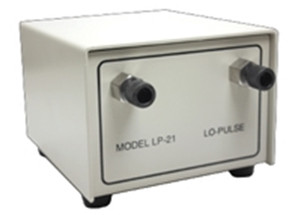Posted by Chrom Tech on 15th Oct 2025
How Does a Pulse Dampener Work in an HPLC Pump?
In high-performance liquid chromatography (HPLC), maintaining a consistent and smooth solvent flow is essential for achieving accurate, reproducible results. Even minor fluctuations in pressure or flow rate can introduce baseline noise in the detector, affecting both quantitation and sensitivity. To minimize these pulsations, many HPLC systems employ a pulse dampener—a device that smooths the flow from reciprocating piston pumps to ensure stable baseline performance.
Why Use a Pulse Dampener?
HPLC pumps, such as the positive-displacement piston pumps offered by Chrom Tech, are designed for precise solvent delivery across a wide range of analytical, clinical, preparative, and metering applications. However, during the piston’s refill cycle, the flow momentarily decreases—causing pressure fluctuations that appear as noise in chromatographic baselines. This pulsation can negatively impact the limit of detection (LOD) and quantitation precision in sensitive assays.
To counteract these effects, Chrom Tech recommends integrating a pulse dampener, which effectively absorbs pressure spikes and stabilizes solvent flow. The LO-Pulse Pulse Dampener is specifically engineered to minimize pump pulsations in flow-sensitive HPLC applications. It can be factory-installed within an HPLC pump or added externally to an existing system for improved performance.
How Does a Pulse Dampener Work?
The LO-Pulse Pulse Dampener operates using a fluid compression mechanism that balances the natural pulsations of reciprocating piston pumps. The device contains an internal cavity divided by a flexible, chemically inert diaphragm. The lower chamber holds a damping fluid that compresses and expands in response to pressure fluctuations in the mobile phase stream.
When system pressure rises during the pump’s forward stroke, the damping fluid compresses slightly, absorbing excess energy. As the piston retracts and pressure momentarily drops, the fluid expands, maintaining consistent flow and pressure through the column. This smooth compensation eliminates flow irregularities that could otherwise produce baseline drift or detector noise.
At operating pressures of 500 psi or higher (ideally above 1,000 psi), the LO-Pulse achieves optimal performance. Its internal volume of approximately 0.9 mL ensures a completely swept flow path, minimizing solvent “memory effects” during mobile phase changes. For maximum dampening efficiency, a short length of small-bore tubing can be installed at the outlet to introduce slight flow restriction.
Benefits of the LO-Pulse Pulse Dampener
- Reduces baseline noise and signal fluctuations in sensitive analyses.
- Improves quantitative precision by maintaining a stable flow rate.
- Minimizes detector noise caused by pump piston cycles.
- Enhances system stability for high-precision gradient and isocratic separations.
- Compatible with both single and dual-piston pumps.
- Automatic operation—no manual adjustments or controls required.
Conclusion
A pulse dampener is a simple yet powerful addition to any HPLC system that uses reciprocating piston pumps. By smoothing solvent flow and reducing pressure fluctuations, it ensures greater analytical accuracy, consistency, and baseline stability. Chrom Tech’s LO-Pulse Pulse Dampener provides proven performance and reliability for demanding chromatography workflows.
Whether you’re integrating a pulse dampener into a new system or retrofitting an existing HPLC pump, Chrom Tech’s solvent delivery pumps and accessories deliver dependable performance. For assistance selecting the right configuration, contact our technical experts at support@chromtech.com.
Frequently Asked Questions About Pulse Dampeners
What does a pulse dampener do in an HPLC system?
A pulse dampener smooths out pressure and flow fluctuations from reciprocating piston pumps, reducing detector noise and improving baseline stability for more accurate chromatographic results.
When should I use a pulse dampener?
A pulse dampener is recommended for high-sensitivity or trace analysis where pump pulsation can impact precision or limit of detection. It’s especially useful in gradient separations and low-flow applications.
Can I retrofit a pulse dampener to my existing HPLC pump?
Yes. Chrom Tech’s LO-Pulse Pulse Dampener can be added externally to most single- or dual-piston pumps, enhancing performance without requiring modifications to your current system.

